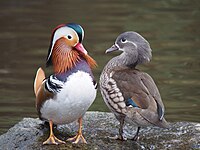
Photo from wikipedia
How selection pressures acting within species interact with developmental constraints to shape macro‐evolutionary patterns of species divergence is still poorly understood. In particular, whether or not sexual selection affects evolutionary… Click to show full abstract
How selection pressures acting within species interact with developmental constraints to shape macro‐evolutionary patterns of species divergence is still poorly understood. In particular, whether or not sexual selection affects evolutionary allometry, the increase in trait size with body size across species, of secondary sexual characters, remains largely unknown. In this context, bovid horn size is an especially relevant trait to study because horns are present in both sexes, but the intensity of sexual selection acting on them is expected to vary both among species and between sexes. Using a unique data set of sex‐specific horn size and body mass including 91 species of bovids, we compared the evolutionary allometry between horn size and body mass between sexes while accounting for both the intensity of sexual selection and phylogenetic relationship among species. We found a nonlinear evolutionary allometry where the allometric slope decreased with increasing species body mass. This pattern, much more pronounced in males than in females, suggests either that horn size is limited by some constraints in the largest bovids or is no longer the direct target of sexual selection in very large species.
Journal Title: Journal of Evolutionary Biology
Year Published: 2017
Link to full text (if available)
Share on Social Media: Sign Up to like & get
recommendations!